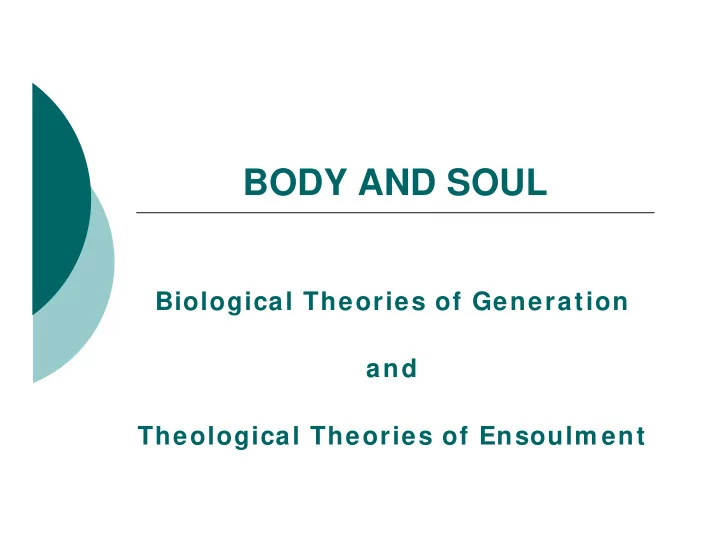

BODY AND SOUL Biological Theories of Generation and Theological Theories of Ensoulm ent
OVERVIEW OF PRESENTATION � History of Embryological Theories � Views of the Soul � Putting Body and Soul Together � Ethical Implications � Theological Implications
EARLY GREEKS—HIPPOCRATICS � Males develop faster than females. � Process involves three stages: � completion of form; � first felt movement; � birth. � Development from unformed to formed or undifferentiated to differentiate is EPI GENESI S .
ARISTOTLE � Development begins as a result of a power of the male parent communicated by spirit or breath (pneuma ) . � Organs form in a progressive manner (inner before outer, head before feet). Aristotle was an epigeneticist. � Males develop more quickly than females and the first movement is felt on woman’s right-hand side.
GALEN AND MIDDLE AGES � Galen borrowed from both Aristotle and the Hippocratics (and so affirmed epigenesis). � The Middle Ages relied on the Hippocratics, Aristotle, and Galen for their understanding of embryological development (and so affirmed epigenesis). Galen Hippocrates Aristotle
17 TH /18 TH CENTURIES: PREFORMATIONISM—1 � Types � Ovism (preformed embryo in egg) � Animalculism (preformed embryo in sperm) � Emboîtement (preformed embryo inside preformed embryo inside preformed embryo; all created in Adam or Eve in the beginning)
PREFORMATIONISM—2 � Basis for theory � Experimental and Observational Evidence � Philosophical and Malpighi Swammerdam Theological Theories � mechanical philosophy � static universe � creation “completed” at the beginning Wolff
18 TH CENTURY—OPPOSITION Pierre-Louis Moreau De Maupertuis (1698 – 1759) and Vénus physique
19 TH CENTURY—EPIGENESIS AGAIN Pander Von Baer Hertwig Fol � Observational data in 19 th century confirmed epigenesis � still no mechanism � reliance on “developmental forces” or “vital spirits,” etc.
20 TH CENTURY � Embryology essentially descriptive through first part of the period. � Modern field of “evo-devo” formed in latter part of 20 th century.
PLATO AND THE SOUL � Soul ( psyche ) is immortal, immaterial, and changeless. � Soul is both “simple” and “tripartite” (with later Platonists identifying “soul” with “mind”). � Soul becomes related to the body at birth. Plato (428/ 427 – 348/ 347 BCE)
ARISTOTLE AND THE SOUL—1 � Soul ( psyche, anima, pneuma ) is better defined as “life-giving force.” � Soul does not exist apart from matter (or the body). Aristotle (384 – 322 BCE)
ARISTOTLE AND THE SOUL—2 � All living things have a soul � Plant — nutritive soul � Animal — nutritive and locomotory souls � Human — nutritive, locomotory, and rational souls � At conception, human has nutritive soul; “humanizing” soul requires 40 days for males and 90 for females and is associated with quickening.
JEWISH VIEWS OF THE SOUL � Early views similar to Aristotle in that body and soul not separate � Nephesh —possessed by all living animals � Translations include “soul,” “life,” “person,” “living being,” “blood,” “desire,” “breath,” … � Issues (and solutions) surrounding the survival of nephesh
SUMMARY OF THESE VIEWS � Plato, Aristotle, and some Jewish views — “delayed ensoulment” � Plato and some Jewish views: soul “arrived” at birth (with first breath) � Aristotle: soul present by quickening � Plato—soul independent of body; continues after death; “essence” of person � Aristotle and most Jewish views—soul does not exist apart from body; not immortal; little to do with identity
15 TH /16 TH CENTURIES—NEOPLATONISM � Pope Leo X (1513)— immortality of the soul a Roman Catholic doctrine � Calvin—“borrowed” Platonic language (but not Platonic himself) � Cambridge Platonists, René Descartes, and Preformationists— soul immortal, immaterial, spiritual entity
ORIGIN OF THE SOUL � Creationist Position: � Jerome (347 – 420) � God creates a new soul for each embryo � Dominant view in Middle Ages � Traducianism: � Tertullian (ca.160 – ca.220) � Each individual’s soul is connected to the soul that Adam received � Advocated by Martin Luther
SYNTHESIS AND IMPLICATIONS—1 � From early Greeks through Middle Ages, � embryo developed epigenetically; � ensoulment “delayed; ” � soul understood in “baptized” Aristotelian manner. � Roman Catholic Church’s views held � embryo not “human” before quickening; � arguments against abortion related to purpose and function of sex and marriage (not to “sanctity” of embryo)
SYNTHESIS AND IMPLICATIONS—2 � With changes in philosophy in the 16 th century, � “delayed ensoulment” not possible; � “soul” became more and more identified with “mind.” � Protestants reject all forms of abortion. � Pope Leo XIII (1886) prohibits all abortions, even to save a woman’s life.
19 TH /20 TH CENTURIES ISSUES � Connection between Darwinism and embryology � Ernst Haeckel’s “ontogeny recapitulates phylogeny” � Karl Rahner (1904- 1984) argued for a return to Aristotelian “delayed ensoulment.”
20 TH CENTURY VIEWS ON SOUL � Substance Dualism � Platonic � Dual Aspect Theory � Aristotelian/ Jewish � Materialism � Secular/ Anti-Spiritual
20 TH CENTURY INFLUENCES � Neurosciences � Absence of brain waves � death � Presence of brain waves � hominization � Implies “delayed ensoulment” and dual aspect theory � Reproductive Medicine � Up to 50% of all conceptions spontaneously aborted before there is knowledge of pregnancy with another 15-20% aborted after implantation � Difficult to reconcile with immediate ensoulment
SO…? � Common societal (church) view primarily Platonic (substance dualism), although some affirm Dual Aspect Theory � “Soul” and “ Imago dei ” � Need to rethink how we formulate ethical arguments � Need to reaffirm and teach more clearly the doctrine of the resurrection of the body.
Recommend
More recommend